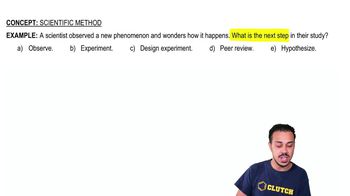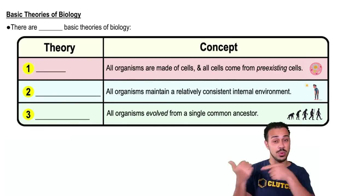Table of contents
- 1. Introduction to Biology2h 42m
- 2. Chemistry3h 40m
- 3. Water1h 26m
- 4. Biomolecules2h 23m
- 5. Cell Components2h 26m
- 6. The Membrane2h 31m
- 7. Energy and Metabolism2h 0m
- 8. Respiration2h 40m
- 9. Photosynthesis2h 49m
- 10. Cell Signaling59m
- 11. Cell Division2h 47m
- 12. Meiosis2h 0m
- 13. Mendelian Genetics4h 44m
- Introduction to Mendel's Experiments7m
- Genotype vs. Phenotype17m
- Punnett Squares13m
- Mendel's Experiments26m
- Mendel's Laws18m
- Monohybrid Crosses19m
- Test Crosses14m
- Dihybrid Crosses20m
- Punnett Square Probability26m
- Incomplete Dominance vs. Codominance20m
- Epistasis7m
- Non-Mendelian Genetics12m
- Pedigrees6m
- Autosomal Inheritance21m
- Sex-Linked Inheritance43m
- X-Inactivation9m
- 14. DNA Synthesis2h 27m
- 15. Gene Expression3h 20m
- 16. Regulation of Expression3h 31m
- Introduction to Regulation of Gene Expression13m
- Prokaryotic Gene Regulation via Operons27m
- The Lac Operon21m
- Glucose's Impact on Lac Operon25m
- The Trp Operon20m
- Review of the Lac Operon & Trp Operon11m
- Introduction to Eukaryotic Gene Regulation9m
- Eukaryotic Chromatin Modifications16m
- Eukaryotic Transcriptional Control22m
- Eukaryotic Post-Transcriptional Regulation28m
- Eukaryotic Post-Translational Regulation13m
- 17. Viruses37m
- 18. Biotechnology2h 58m
- 19. Genomics17m
- 20. Development1h 5m
- 21. Evolution3h 1m
- 22. Evolution of Populations3h 52m
- 23. Speciation1h 37m
- 24. History of Life on Earth2h 6m
- 25. Phylogeny2h 31m
- 26. Prokaryotes4h 59m
- 27. Protists1h 12m
- 28. Plants1h 22m
- 29. Fungi36m
- 30. Overview of Animals34m
- 31. Invertebrates1h 2m
- 32. Vertebrates50m
- 33. Plant Anatomy1h 3m
- 34. Vascular Plant Transport1h 2m
- 35. Soil37m
- 36. Plant Reproduction47m
- 37. Plant Sensation and Response1h 9m
- 38. Animal Form and Function1h 19m
- 39. Digestive System1h 10m
- 40. Circulatory System1h 57m
- 41. Immune System1h 12m
- 42. Osmoregulation and Excretion50m
- 43. Endocrine System1h 4m
- 44. Animal Reproduction1h 2m
- 45. Nervous System1h 55m
- 46. Sensory Systems46m
- 47. Muscle Systems23m
- 48. Ecology3h 11m
- Introduction to Ecology20m
- Biogeography14m
- Earth's Climate Patterns50m
- Introduction to Terrestrial Biomes10m
- Terrestrial Biomes: Near Equator13m
- Terrestrial Biomes: Temperate Regions10m
- Terrestrial Biomes: Northern Regions15m
- Introduction to Aquatic Biomes27m
- Freshwater Aquatic Biomes14m
- Marine Aquatic Biomes13m
- 49. Animal Behavior28m
- 50. Population Ecology3h 41m
- Introduction to Population Ecology28m
- Population Sampling Methods23m
- Life History12m
- Population Demography17m
- Factors Limiting Population Growth14m
- Introduction to Population Growth Models22m
- Linear Population Growth6m
- Exponential Population Growth29m
- Logistic Population Growth32m
- r/K Selection10m
- The Human Population22m
- 51. Community Ecology2h 46m
- Introduction to Community Ecology2m
- Introduction to Community Interactions9m
- Community Interactions: Competition (-/-)38m
- Community Interactions: Exploitation (+/-)23m
- Community Interactions: Mutualism (+/+) & Commensalism (+/0)9m
- Community Structure35m
- Community Dynamics26m
- Geographic Impact on Communities21m
- 52. Ecosystems2h 36m
- 53. Conservation Biology24m
1. Introduction to Biology
Scientific Method
Problem 5`
Textbook Question
Which of the following statements best distinguishes hypotheses from theories in science?
a. Theories are hypotheses that have been proved.
b. Hypotheses are guesses; theories are correct answers.
c. Hypotheses usually are relatively narrow in scope; theories have broad explanatory power.
d. Theories are proved true; hypotheses are often contradicted by experimental results.
 Verified step by step guidance
Verified step by step guidance1
Understand the definitions: A hypothesis is a proposed explanation for a phenomenon, typically based on limited evidence as a starting point for further investigation. A theory, on the other hand, is a well-substantiated explanation acquired through the scientific method and repeatedly tested and confirmed through observation and experimentation.
Consider the scope: Hypotheses are usually specific and narrow in scope, focusing on a particular aspect or question. Theories, however, are broader and provide a comprehensive explanation that can encompass multiple hypotheses and observations.
Evaluate the process of validation: Hypotheses are tested through experiments and observations. If the results consistently support the hypothesis, it may contribute to the development of a theory. Theories are not 'proved' in the absolute sense but are supported by a significant body of evidence.
Reflect on the nature of scientific inquiry: Science is iterative and self-correcting. Hypotheses can be contradicted by experimental results, leading to refinement or rejection. Theories, while robust, are still open to revision if new evidence emerges.
Choose the statement that aligns with these concepts: Based on the understanding of hypotheses and theories, select the statement that accurately reflects their relationship and characteristics in scientific practice.
 Verified video answer for a similar problem:
Verified video answer for a similar problem:This video solution was recommended by our tutors as helpful for the problem above
Video duration:
1mPlay a video:
Was this helpful?
Key Concepts
Here are the essential concepts you must grasp in order to answer the question correctly.
Hypothesis
A hypothesis is a tentative explanation or prediction that can be tested through experimentation and observation. It is usually narrow in scope, focusing on a specific aspect of a phenomenon, and serves as a starting point for scientific investigation. Hypotheses are formulated based on existing knowledge and are subject to validation or refutation through empirical evidence.
Recommended video:
Guided course

Predictions, Hypotheses, & Theories
Theory
A theory is a well-substantiated explanation of some aspect of the natural world that is based on a body of evidence and has withstood repeated testing and validation. Theories have broad explanatory power, integrating and generalizing findings from multiple studies to provide a comprehensive understanding of complex phenomena. Unlike hypotheses, theories are widely accepted within the scientific community due to their robust support.
Recommended video:
Guided course

Endosymbiotic Theory
Scientific Method
The scientific method is a systematic approach to inquiry that involves formulating hypotheses, conducting experiments, collecting data, and analyzing results to draw conclusions. It is essential for distinguishing between hypotheses and theories, as it provides a structured framework for testing ideas and building knowledge. Through iterative cycles of testing and refinement, the scientific method helps transform hypotheses into theories when sufficient evidence accumulates.
Recommended video:
Guided course

Scientific Method
Related Videos
Related Practice












